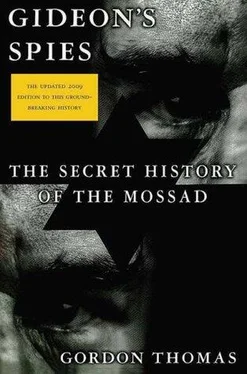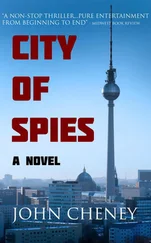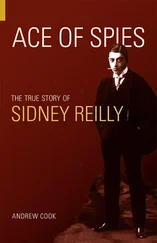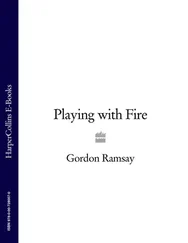In the hours that had passed since Vanunu was being flown to London by the Sunday Times, Guerrero had tried to make a quick killing—by offering copies of Vanunu’s documentation to two Australian newspapers. They had dismissed the material as forgeries.
Growing desperate, Guerrero had set off to London in pursuit of Vanunu. Unable to find him, Guerrero had taken the documents to the Sunday Mirror . Included was a photograph of Vanunu taken in Australia. Within hours Nicholas Davies knew they were there. He promptly told Maxwell. The publisher called Admoni. Several hours later, when the Mossad chief again called Maxwell, Admoni received another jolt. The Sunday Times was taking Vanunu’s story seriously. It was therefore critically important to know what the technician had photographed. It was hoped a damage-limitation response could then be fashioned. The reports from Canberra suggested that Guerrero was clearly motivated by money. If Vanunu was shown to have a similar aspiration, then it might be possible to mount a successful disinformation campaign that the Sunday Times had been swindled by two con men.
Once more the indefatigable Ari Ben-Menashe was pressed into service. Admoni ordered him to fly to London to obtain the copies that Guerrero had shown to the Sunday Mirror . Ben-Menashe would later recall to the veteran American investigative journalist Seymour Hersh:
“Nicholas Davies had arranged for Guerrero to meet this ‘hot’ American journalist—me. At the meeting, Guerrero, eager for another sale, displayed some of Vanunu’s color photographs. I had no idea if they were significant. They needed to be seen by experts in Israel. I told Guerrero I needed copies. He balked. I said I had to know if they were real if he wanted money and that Nick would vouch for me.”
Guerrero handed over several photographs to Ben-Menashe. They were couriered to Tel Aviv.
Their arrival created further consternation. Officials from Dimona identified Machon-Two from the photographs. One of the prints showed the area where nuclear land mines had been manufactured before being sown along the Golan Heights border with Syria. There was no longer any question of being able to destroy Vanunu’s credibility. Every nuclear physicist would recognize what the equipment was for.
Prime Minister Peres set up a crisis team to monitor the situation. Some of Mossad’s department heads urged that a kidon squad should be sent to London to hunt down Vanunu and kill him. Admoni rejected the idea. The Sunday Times would not have the space to publish everything Vanunu told the newspaper; it would require a full-length book to contain all the information to which the technician would have had access. But once the newspaper had finished with Vanunu, the likeliest possibility was he would then be debriefed by MI6 and the CIA, and Israel would face even more problems. It was all the more imperative to learn how Vanunu had carried out his spying activities in Dimona and whether he had worked alone or with others—and if so, whom they were working for. The only way to discover all this was to bring Vanunu back to Israel to be interrogated.
Admoni needed a way to flush the technician out of wherever the Sunday Times had hidden him. In the open it would be easier to deal with Vanunu, and in the end, if he had to be killed, it would not be the first time Mossad had committed murder on the streets of London. In the hunt for the perpetrators of the massacre of the Israeli athletes at the Munich Olympics, Mossad had killed one of the Black September group in a carefully staged hit-and-run road accident as he walked back to his Bloomsbury hotel.
In London, the Sunday Times, realizing Israel would do everything possible to discredit Vanunu, had arranged for him to be questioned by Dr. Frank Barnaby, a nuclear physicist with impeccable credentials who had worked at Britain’s nuclear weapons installation at Aldermaston. He concluded that the photographs and documentation were authentic and the technician’s detailed recall was accurate.
The Sunday Times then took a fateful step. Its reporter presented the Israeli embassy in London with a summary of all that Vanunu had revealed to them, along with photostats of his passport and the photographs, together with Barnaby’s assessment. The intention was to force an admission from the Israeli government. Instead, the embassy dismissed the material as “having no base whatsoever in reality.”
In Tel Aviv the photocopies presented to the embassy caused further consternation. For Ben-Menashe:
“The cat was out of the bag. I was still in London when Davies said Maxwell wanted to see me. We met in the same office where I had agreed to pay him $8 million commission for hiding our money behind the Iron Curtain. Maxwell made it clear he understood what was to be done about the Vanunu story. He said he had already spoken to my boss in Tel Aviv.”
As a result of that call, Admoni had finally come up with a way to drive Vanunu into the open.
The next issue of the Sunday Mirror contained a large photograph of Mordechai Vanunu, together with a story holding the technician and Oscar Guerrero up to ridicule, calling the Colombian a liar and a cheat, and the claim about Israel’s nuclear capability a hoax. The report had been dictated by Maxwell who had also supervised the prominent positioning of Vanunu’s photograph. The first shot had been fired in a major disinformation campaign orchestrated by Mossad’s psychological warfare department.
After reading it, Vanunu became agitated to the point where he told his Sunday Times “minders”—the reporters who had watched over him since he had been brought to London—that he “wanted to disappear. I don’t want anyone to know where I am.”
The panic-stricken technician was staying at the latest hotel his minders had chosen, the Mountbatten near Shaftesbury Avenue in Central London.
Following the Sunday Mirror publication, sayanim in London were mobilized to find him. Scores of trusted Jewish volunteers had each been given lists of hotels and boarding houses to check. In each call they gave a description of Vanunu from the photograph published in the Sunday Mirror, each caller claiming to be a relative checking to see if he had registered.
On Wednesday, September 25, Admoni received news from London that Vanunu had been located. It was time to bring into play the next stage of his plan.
The link between intelligence work and sexual entrapment was as old as spying itself. In the fourth book of Moses, Rahab, a prostitute, saves the lives of two of Joshua’s spies from the king of Jericho’s counterintelligence people—the first recorded meeting between the world’s two oldest professions. One of Rahab’s heirs in the love-and-espionage business was Mata Hari, a Dutch seductress who worked for the Germans in World War I and was executed by the French. From the beginning Mossad had recognized the value of sexual entrapment. For Meir Amit:
“It was another weapon. A woman has skills a man simply does not. She knows how to listen. Pillow talk is not a problem for her. The history of modern intelligence is filled with accounts of women who have used their sex for the good of their country. To say that Israel has not done the same would be foolish. But our women are volunteers, high-minded women who know the risks involved. That takes a special kind of courage. It is not so much a question of sleeping with someone. It is to lead a man to believe you will do so in return for what he has to tell you. That does not begin to describe the great skills that are called into play to achieve that.”
Nahum Admoni had handpicked an agent who possessed all those qualities to entice Mordechai Vanunu into Mossad’s hands.
Читать дальше












